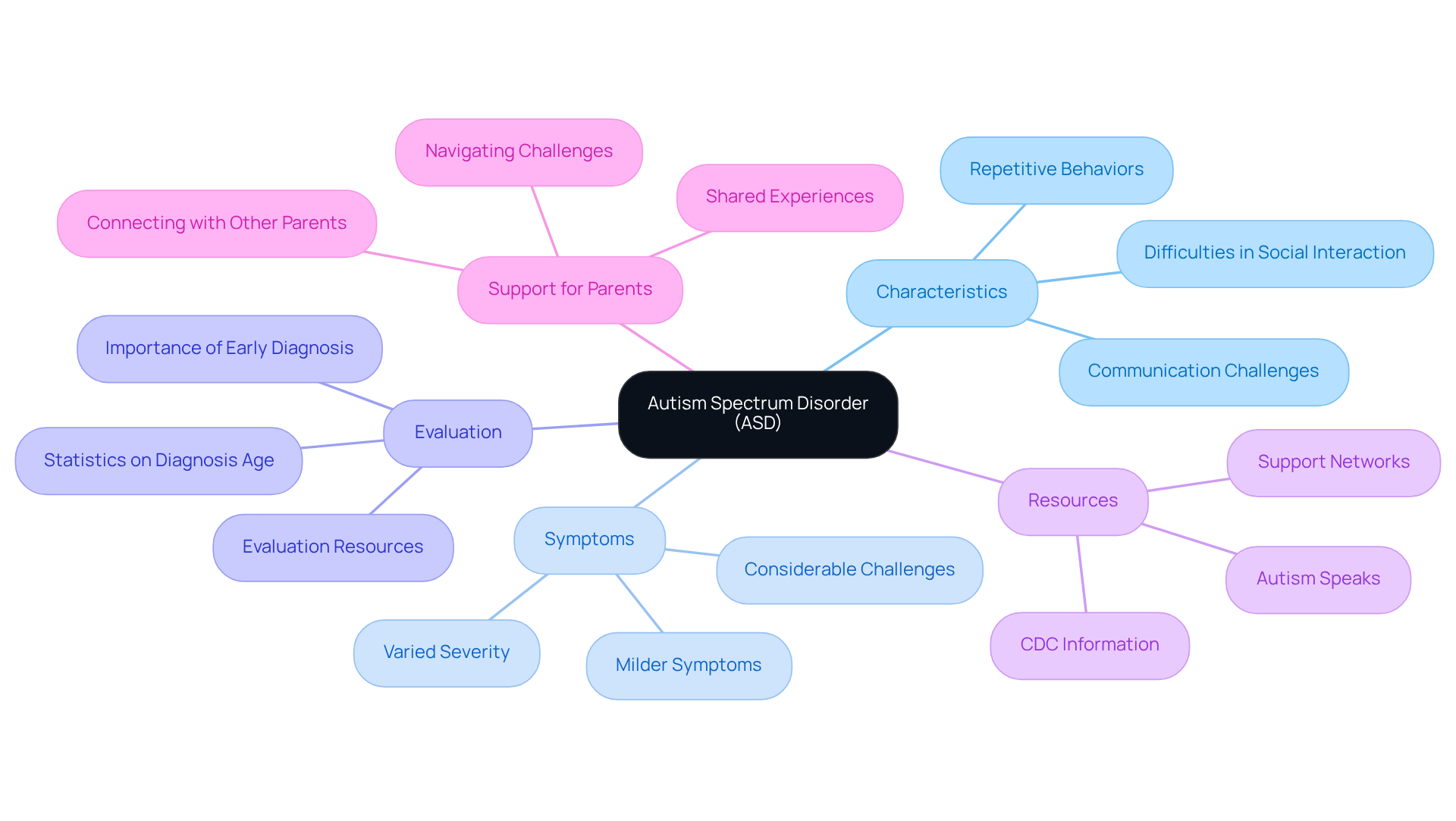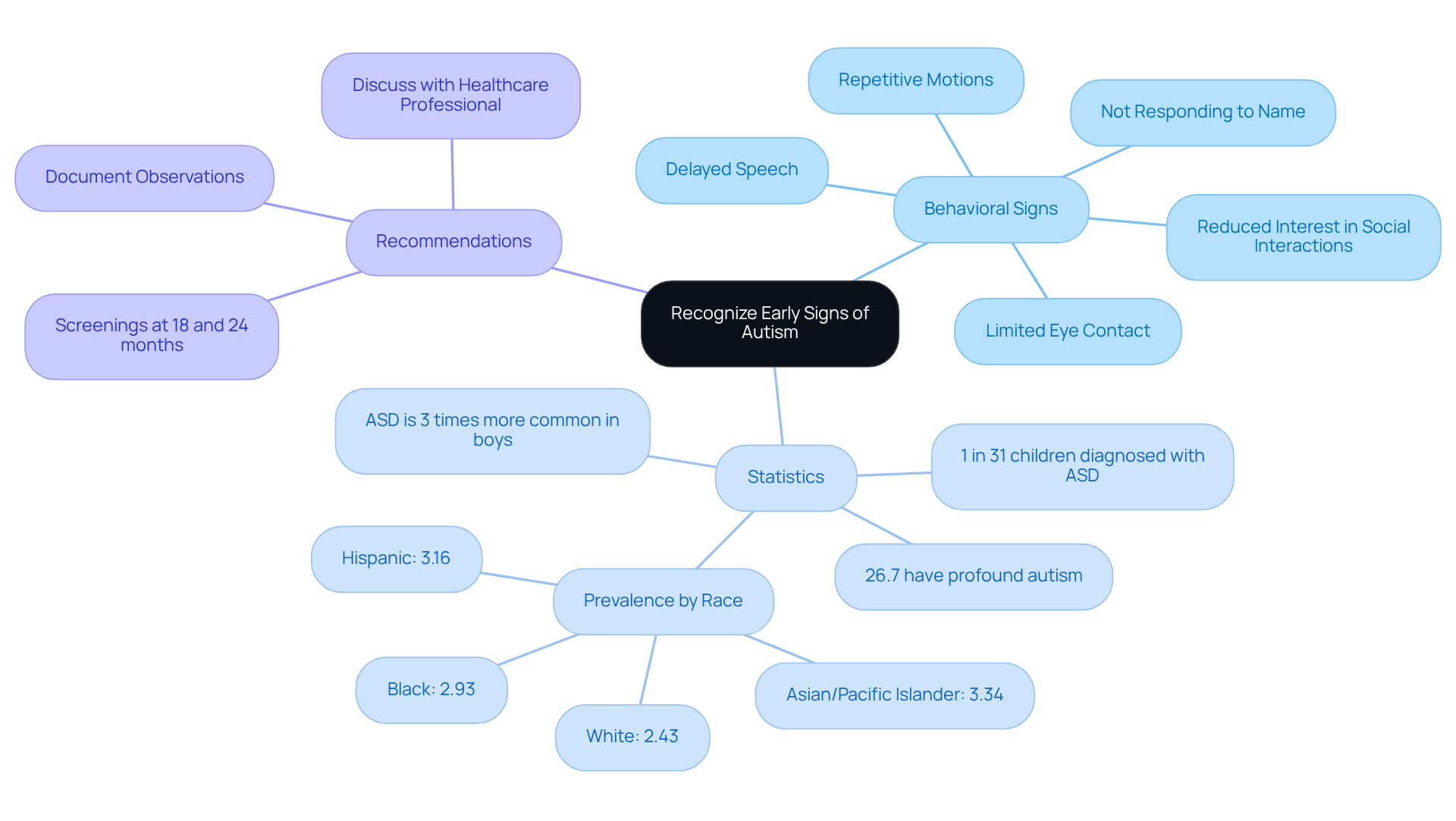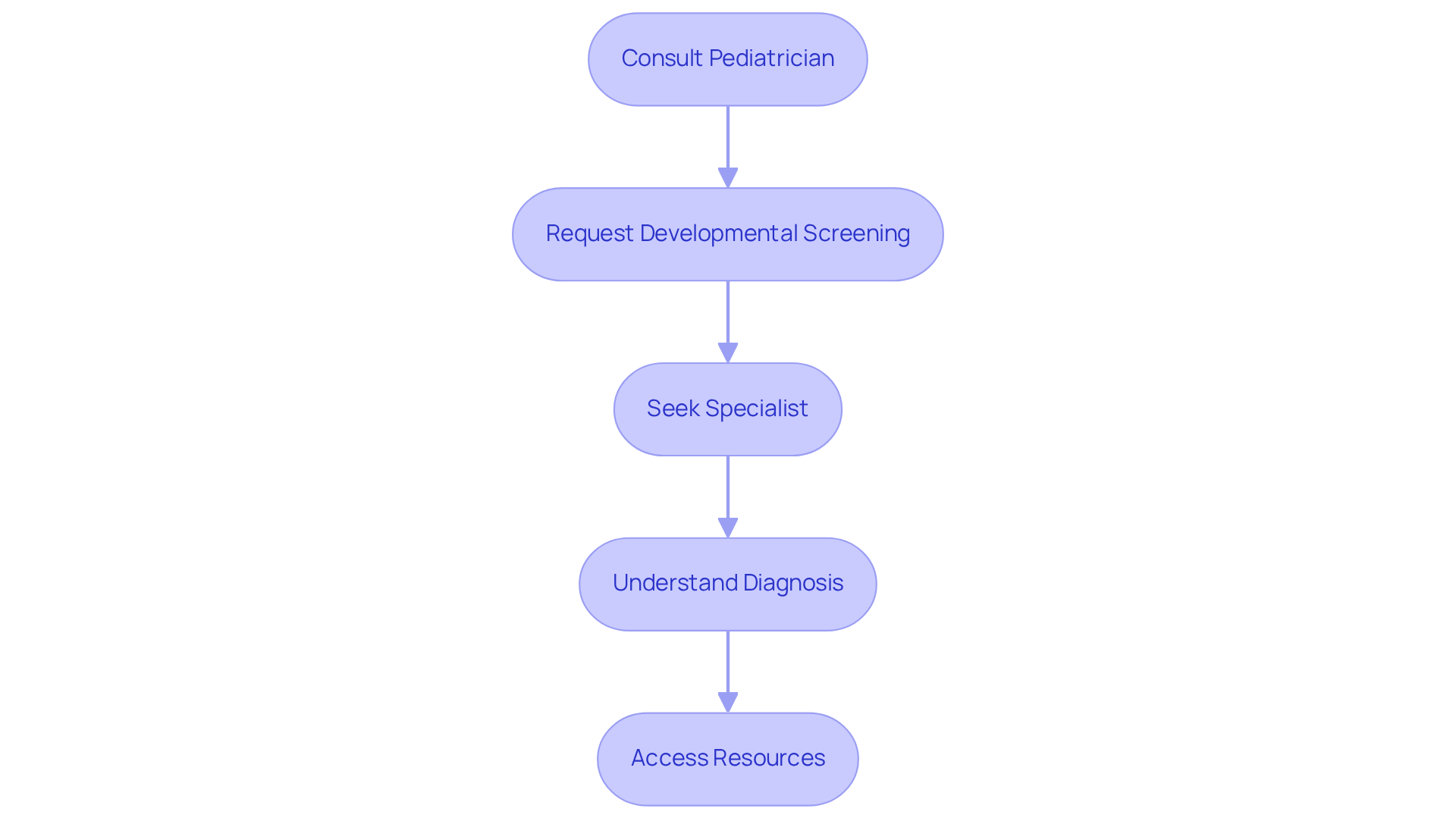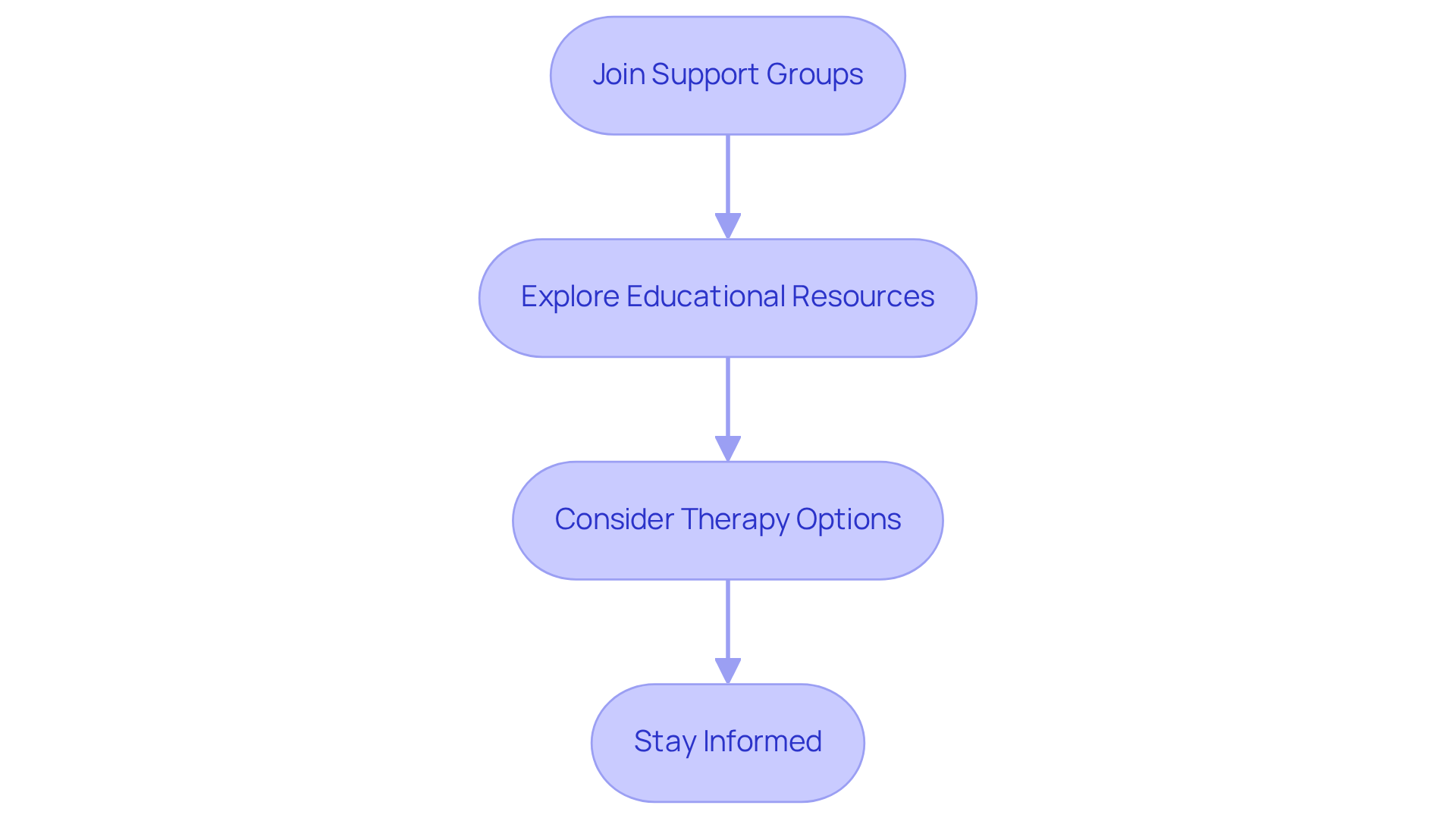Overview
As a parent, recognizing the early signs of autism in your child can be a daunting journey. Look for indicators such as:
- Limited eye contact
- Delayed speech
- Reduced interest in social interactions
If you notice these behaviors, it’s crucial to seek a professional assessment. Early recognition can make a significant difference in your child's development.
Understanding these signs is essential, and resources from organizations like the CDC and Autism Speaks can be invaluable. They offer guidance on specific behaviors to monitor and the steps to take for evaluation and support. Remember, you are not alone in this; many parents face similar challenges, and reaching out for help is a strong and positive step forward.
By being proactive, you can ensure that your child receives the support they need. Take the time to observe and reflect on your child's behavior, and don’t hesitate to seek assistance. Together, we can foster a nurturing environment for children with autism and help them thrive.
Introduction
Navigating the complexities of Autism Spectrum Disorder (ASD) can feel daunting for parents. The challenge of identifying early signs in their children often adds to this stress. This guide provides essential insights into recognizing the indicators of autism, highlighting the critical importance of early diagnosis and intervention.
How can parents embark on this intricate journey and ensure their child receives the support they need? By exploring key steps and available resources, they can transform uncertainty into informed action. This proactive approach not only fosters understanding but also paves the way for a brighter future for their child.
Understand Autism Spectrum Disorder (ASD)
Autism Spectrum Disorder (ASD) is a developmental disorder that can be challenging for many families. It is characterized by difficulties in social interaction, communication, and repetitive behaviors. As a parent, it’s crucial to understand that ASD exists on a spectrum, meaning that symptoms can vary significantly from one individual to another. Some children may face considerable challenges, while others might exhibit milder symptoms.
By familiarizing yourself with the definition and characteristics of ASD, you can better understand how can you tell if your child has autism and recognize when they may benefit from further evaluation. This understanding can be a vital step in ensuring your child receives the support they need. Resources such as the CDC and Autism Speaks offer comprehensive information about ASD, including its prevalence and the importance of early diagnosis.
Remember, you are not alone on this journey. Many parents share similar experiences and seek the best for their children. Engaging with these resources can provide you with valuable insights and support. We encourage you to explore these organizations and connect with others who understand the challenges and triumphs of raising a child with ASD.

Recognize Early Signs of Autism
As parents, it’s natural to feel concerned about your child's development. Initial signs of certain conditions can emerge in various ways, often before the age of two. It’s important to stay attentive to specific behaviors that might indicate a developmental concern, such as:
- Limited or absent eye contact, which may look like avoiding looking at others.
- Not responding to their name when called, suggesting challenges in social engagement.
- A reduced interest in social interactions or play, indicating difficulties in connecting with peers.
- Delayed speech or language skills, which can hinder effective communication.
- Repetitive motions or actions, like hand-flapping or rocking, commonly seen in individuals on the spectrum.
Recent studies remind us that around 20% of individuals with autism show limited eye contact, a crucial early sign according to the CDC. Additionally, about 1 in 31 children aged 8 years have been identified with Autism Spectrum Disorder (ASD), underscoring the importance of early detection. Organizations like the CDC and Autism Speaks provide valuable resources that list signs to watch for. The American Academy of Pediatrics recommends screenings for developmental disorders at 18 and 24 months, emphasizing that early diagnosis can lead to interventions that significantly improve developmental outcomes for those on the spectrum.
If you notice any of these behaviors in your child, it’s essential to document your observations and discuss how can you tell if your child has autism with a healthcare professional. Taking this step can facilitate timely evaluation and support, ensuring your child receives the care they need.

Seek Professional Assessment and Diagnosis
Recognizing how can you tell if your child has autism can be a daunting experience. The next crucial step is to seek a professional assessment, especially regarding how can you tell if your child has autism, and we’re here to guide you through this process with care and understanding.
To determine how can you tell if your child has autism, start by consulting your pediatrician. Share your concerns openly; they can provide initial guidance on how can you tell if your child has autism and may also refer you to a specialist who can help further.
Next, you should consider how can you tell if your child has autism by requesting a developmental screening. This may involve filling out questionnaires about your child's behavior and development, which can help answer how can you tell if your child has autism and provide valuable insights.
If necessary, seek out a psychologist or developmental pediatrician who specializes in autism assessments to learn how can you tell if your child has autism. They will conduct a comprehensive evaluation, which may include interviews, observations, and standardized tests to determine how can you tell if your child has autism and understand their unique needs.
Once a diagnosis is made, understanding how can you tell if your child has autism is crucial for your child's development. Ask the specialist to clarify the diagnosis and discuss its implications, particularly how can you tell if your child has autism, so you can feel informed and supported.
Remember, resources such as the Autism Society and the CDC can help you find qualified professionals in your area. You are not alone on this journey; support is available to help you and your child navigate the path ahead.

Access Resources and Support After Diagnosis
After receiving a diagnosis of a spectrum disorder, it's crucial to access resources and support for your child's development. Here are some important steps to consider:
-
Join Support Groups: Connecting with other parents can provide invaluable emotional support and practical advice. Research indicates that approximately 66.4% of families with children diagnosed with the condition have participated in tailored support groups, finding them especially beneficial when facing severe symptoms. Look for local or online support groups designed for individuals on the spectrum; they can significantly reduce feelings of isolation and provide essential information for overcoming challenges.
-
Explore Educational Resources: Various organizations, such as Autism Speaks and the National Autism Association, offer comprehensive toolkits and guides to help parents understand the condition and explore educational options. These resources empower you to advocate effectively for your child's needs within the educational system.
-
Consider Therapy Options: Behavioral therapies, particularly Applied Behavior Analysis (ABA), have shown considerable effectiveness in enhancing communication and social skills in children with autism. Studies suggest that those undergoing ABA therapy before age four exhibit significant improvements in social abilities and communication. Investigate local providers and inquire about their specific methods to ensure they align with your child's needs.
-
Stay Informed: Subscribing to newsletters from organizations focused on developmental disorders keeps you informed about the latest research, resources, and community events. This ongoing education can deepen your understanding of autism and the support systems available, allowing you to make informed decisions for your child.
By actively seeking these resources, you can cultivate a supportive network that empowers both you and your child throughout this journey.

Conclusion
Understanding whether a child has Autism Spectrum Disorder (ASD) is a journey that calls for patience, awareness, and proactive steps. By recognizing the signs and seeking professional evaluation, parents can play a pivotal role in ensuring their child's developmental needs are met. While the complexities of ASD may seem daunting, the right knowledge and resources empower parents to navigate this path with confidence.
Key insights discussed in this article highlight the importance of early detection, the recognition of specific behaviors that may indicate autism, and the necessity of professional assessments. Engaging with healthcare professionals and utilizing available resources can lead to timely interventions that significantly improve outcomes for children on the spectrum. Support networks and educational tools are vital for both parents and children, fostering a nurturing environment that promotes growth and understanding.
Ultimately, the journey of identifying and supporting a child with autism is profoundly enriched by community, knowledge, and timely action. Parents are encouraged to stay informed, seek help, and connect with others who understand the challenges of raising a child with ASD. By doing so, they not only empower themselves but also create a brighter future for their children.
Frequently Asked Questions
What is Autism Spectrum Disorder (ASD)?
Autism Spectrum Disorder (ASD) is a developmental disorder characterized by difficulties in social interaction, communication, and repetitive behaviors.
How does ASD vary among individuals?
ASD exists on a spectrum, meaning symptoms can vary significantly from one individual to another. Some children may face considerable challenges, while others might exhibit milder symptoms.
Why is it important for parents to understand ASD?
Understanding ASD can help parents recognize signs that may indicate their child has autism and determine when further evaluation might be beneficial. This knowledge is crucial for ensuring that their child receives the necessary support.
Where can parents find more information about ASD?
Parents can find comprehensive information about ASD from resources such as the CDC and Autism Speaks, which cover topics like prevalence and the importance of early diagnosis.
How can parents connect with others who have similar experiences?
Engaging with resources and organizations focused on ASD can provide insights and support, allowing parents to connect with others who understand the challenges and triumphs of raising a child with autism.




